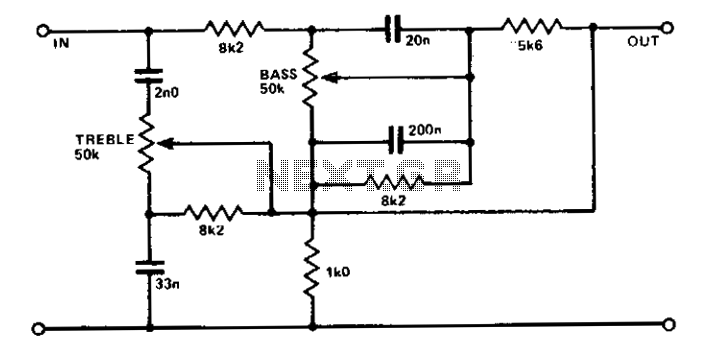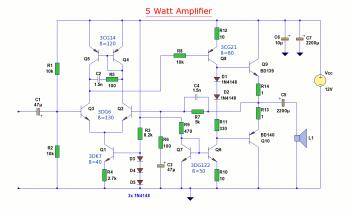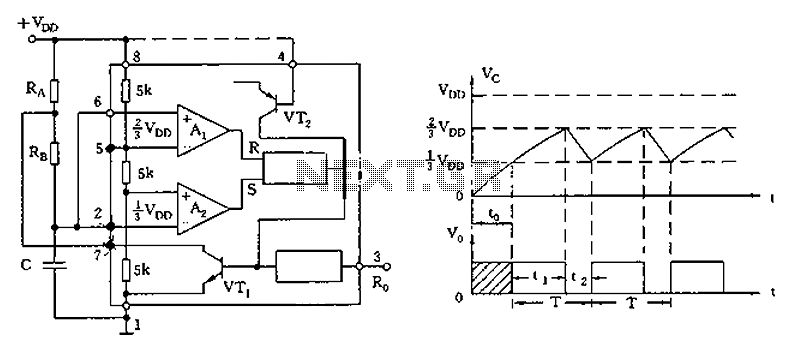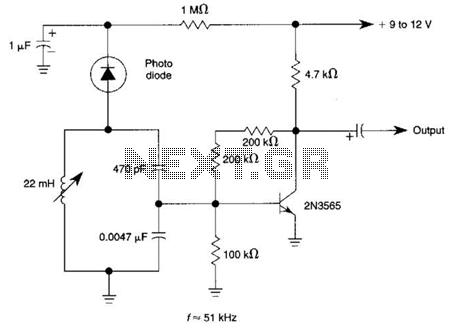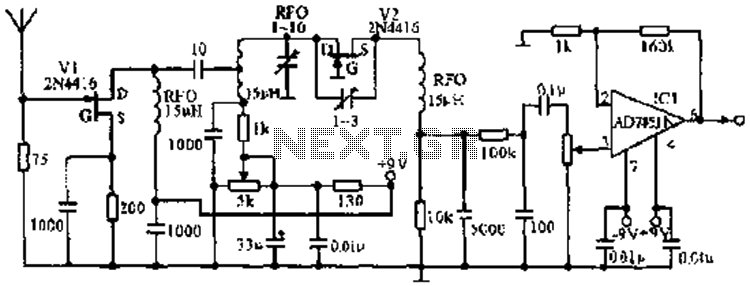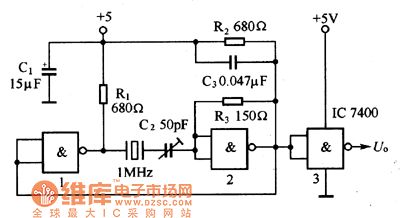
Thermometer circuit schematic using operational amplifiers

A simple thermometer can be constructed using operational amplifiers and a standard or protective diode, such as the 1N4148, as depicted in the electronic diagram below. A constant reference voltage is supplied to the non-inverting input of the operational amplifier. The current flowing through the diode is maintained at a steady level. Variations in the output voltage of the operational amplifier occur solely due to changes in the voltage drop across the diode, which is influenced by temperature fluctuations. The output voltage is directly proportional to the temperature of the diode. The non-inverting input of amplifier A3 is kept at a constant level, achieved with resistors R3, P1, and R4. The values of resistors R6 and R8 are selected such that 0 V corresponds to an ambient temperature of 0 degrees Celsius. To measure temperatures above and below zero without requiring a symmetrical power supply, a voltage regulator (IC1) is utilized, along with amplifiers A2 and A3, to generate a sufficiently stable reference voltage. An additional amplifier, A1, in conjunction with resistors R1 and R2, produces a voltage of 2.5 V relative to the negative power rail, which is then used as the 2.5 V reference for the remainder of the circuit. For continuous operation, a single power source is recommended, as IC1 does not require stabilization. The circuit is calibrated by adjusting potentiometer P1 to achieve 0 V at 0 °C, followed by adjusting P2 to obtain 0.999 V at 99.9 °C.
The described thermometer circuit employs operational amplifiers to create a temperature sensing device that is both simple and effective. The operational amplifier configuration allows for precise measurement of the diode's voltage drop, which varies with temperature. The diode acts as a temperature sensor, where its forward voltage drop decreases as temperature increases. This relationship is exploited in the circuit design, allowing for a linear output voltage that correlates to temperature readings.
The non-inverting input of amplifier A3 is stabilized using a voltage divider formed by R3, P1, and R4, ensuring that the reference voltage remains constant despite variations in supply voltage or temperature. The choice of resistors R6 and R8 is critical, as they define the scale of the output voltage in relation to temperature, specifically calibrating the circuit to output 0 V at 0 °C. The use of a voltage regulator (IC1) is essential for maintaining a stable reference voltage, particularly when measuring temperatures that fall below or above the freezing point, as it allows the circuit to operate without a dual power supply.
Amplifier A1, along with resistors R1 and R2, generates a reference voltage of 2.5 V, which serves as a midpoint reference for the operational amplifiers in the circuit. This design choice facilitates the use of a single power supply and simplifies the overall circuit architecture. Calibration is performed using potentiometers P1 and P2, allowing the user to fine-tune the output voltage to match the desired temperature readings accurately.
In summary, this thermometer circuit is a practical application of operational amplifiers and diodes, providing a straightforward method for temperature measurement with a clear linear output. The design emphasizes stability and ease of calibration, making it suitable for various applications where temperature monitoring is required.A simple thermometer built with operational amplifiers and a normal or protective diode such as 1N4148, instead of the temperature sensor can be made using electronic diagram below. A constant reference voltage is applied to the noninverting input of operational amplifier. Current passing through the diode, is also maintained at a constant level. Variations in operational amplifier output voltage can appear only as a result of a change in diode voltage drop and this, in turn, can be caused only by variations in temperature. The output voltage is directly proportional to the diode temperature. Noninverting input of A3 is maintained at a constant level (also obtained with R3 / P1 / r4) and the values of R6 and R8 were chosen so that 0 V to correspond to an ambient temperature of 0 degrees C.
In order to measure above and below zero without the use of a symmetrical supply is necessary to use a regulator IC1, A2 and A3 for generating a reference voltage steady enough. An additional amplifier, A1, together with R1 and R2, generates a voltage of 2. 5 V relative to the negative power bar. These are then used as 2. 5 V for the rest of the circuit board. If you need a continuous, you must use a single power source, for IC1 does not need to be stabilized.
The circuit is calibrated by adjusting P1 IUI, to obtain 0 V at 0 ° C, and then P2, to get 0. 999 V to 99. 9 ° C 🔗 External reference
The described thermometer circuit employs operational amplifiers to create a temperature sensing device that is both simple and effective. The operational amplifier configuration allows for precise measurement of the diode's voltage drop, which varies with temperature. The diode acts as a temperature sensor, where its forward voltage drop decreases as temperature increases. This relationship is exploited in the circuit design, allowing for a linear output voltage that correlates to temperature readings.
The non-inverting input of amplifier A3 is stabilized using a voltage divider formed by R3, P1, and R4, ensuring that the reference voltage remains constant despite variations in supply voltage or temperature. The choice of resistors R6 and R8 is critical, as they define the scale of the output voltage in relation to temperature, specifically calibrating the circuit to output 0 V at 0 °C. The use of a voltage regulator (IC1) is essential for maintaining a stable reference voltage, particularly when measuring temperatures that fall below or above the freezing point, as it allows the circuit to operate without a dual power supply.
Amplifier A1, along with resistors R1 and R2, generates a reference voltage of 2.5 V, which serves as a midpoint reference for the operational amplifiers in the circuit. This design choice facilitates the use of a single power supply and simplifies the overall circuit architecture. Calibration is performed using potentiometers P1 and P2, allowing the user to fine-tune the output voltage to match the desired temperature readings accurately.
In summary, this thermometer circuit is a practical application of operational amplifiers and diodes, providing a straightforward method for temperature measurement with a clear linear output. The design emphasizes stability and ease of calibration, making it suitable for various applications where temperature monitoring is required.A simple thermometer built with operational amplifiers and a normal or protective diode such as 1N4148, instead of the temperature sensor can be made using electronic diagram below. A constant reference voltage is applied to the noninverting input of operational amplifier. Current passing through the diode, is also maintained at a constant level. Variations in operational amplifier output voltage can appear only as a result of a change in diode voltage drop and this, in turn, can be caused only by variations in temperature. The output voltage is directly proportional to the diode temperature. Noninverting input of A3 is maintained at a constant level (also obtained with R3 / P1 / r4) and the values of R6 and R8 were chosen so that 0 V to correspond to an ambient temperature of 0 degrees C.
In order to measure above and below zero without the use of a symmetrical supply is necessary to use a regulator IC1, A2 and A3 for generating a reference voltage steady enough. An additional amplifier, A1, together with R1 and R2, generates a voltage of 2. 5 V relative to the negative power bar. These are then used as 2. 5 V for the rest of the circuit board. If you need a continuous, you must use a single power source, for IC1 does not need to be stabilized.
The circuit is calibrated by adjusting P1 IUI, to obtain 0 V at 0 ° C, and then P2, to get 0. 999 V to 99. 9 ° C 🔗 External reference
